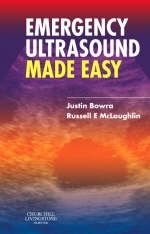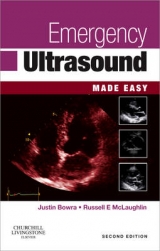
Emergency Ultrasound Made Easy
Seiten
2006
Churchill Livingstone (Verlag)
978-0-443-10150-2 (ISBN)
Churchill Livingstone (Verlag)
978-0-443-10150-2 (ISBN)
- Titel ist leider vergriffen;
keine Neuauflage - Artikel merken
Zu diesem Artikel existiert eine Nachauflage
USS is a safe imaging technique. This book is a pocket-sized, practical introduction, and ready reference to focused ultrasound (USS) in the Emergency Department (ED). It explains the indications for, and use of, limited USS, as well as explains its limitations.
This book is a pocket-sized, practical introduction, and ready reference to focused ultrasound (USS) in the Emergency Department (ED). USS is a safe, rapid imaging technique. It is non-invasive and painless and it is used widely by radiologists, cardiologists (echocardiography) and obstetricians. However, it is only in recent years that its role has emerged in the field of Emergency Medicine. In this context, limited Emergency USS is used to answer very specific questions, such as the presence or absence of AAA (abdominal aortic aneurysm), or of free fluid (such as blood) in the abdomen after trauma. Unlike other imaging modalities (eg CT scan) it is a rapid technique that can 'come to the patient'. The book explains the indications for, and use of, limited USS. Importantly, it also explains its limitations.
This book is a pocket-sized, practical introduction, and ready reference to focused ultrasound (USS) in the Emergency Department (ED). USS is a safe, rapid imaging technique. It is non-invasive and painless and it is used widely by radiologists, cardiologists (echocardiography) and obstetricians. However, it is only in recent years that its role has emerged in the field of Emergency Medicine. In this context, limited Emergency USS is used to answer very specific questions, such as the presence or absence of AAA (abdominal aortic aneurysm), or of free fluid (such as blood) in the abdomen after trauma. Unlike other imaging modalities (eg CT scan) it is a rapid technique that can 'come to the patient'. The book explains the indications for, and use of, limited USS. Importantly, it also explains its limitations.
1.Introduction 2.How ultrasound works 3.Abdominal aorta 4.Focused Assessment with Sonography in Trauma (FAST) 5.Deep vein thrombosis (DVT) 6.The painful hip 7.Central venous access 8.Soft-tissue foreign bodies 9.Draining pleural effusions and ascites 10.Shock and cardiac arrest 11.Renal tract 12.Gallbladder 13.Early pregnancy 14.Getting trained and staying trained 15.Setting up an emergency ultrasound service 16.Conclusion Appendix 1. Useful paperwork Appendix 2. Useful organisations Appendix 3. Further reading
| Erscheint lt. Verlag | 10.5.2006 |
|---|---|
| Reihe/Serie | Made Easy |
| Zusatzinfo | Approx. 200 illustrations |
| Verlagsort | London |
| Sprache | englisch |
| Maße | 123 x 186 mm |
| Gewicht | 1000 g |
| Themenwelt | Medizin / Pharmazie ► Medizinische Fachgebiete ► Notfallmedizin |
| Medizinische Fachgebiete ► Radiologie / Bildgebende Verfahren ► Sonographie / Echokardiographie | |
| ISBN-10 | 0-443-10150-7 / 0443101507 |
| ISBN-13 | 978-0-443-10150-2 / 9780443101502 |
| Zustand | Neuware |
| Haben Sie eine Frage zum Produkt? |
Mehr entdecken
aus dem Bereich
aus dem Bereich
Begleitbuch für Sonografiekurse, Klinik und Praxis
Buch | Softcover (2023)
Urban & Fischer in Elsevier (Verlag)
CHF 37,80
Organbezogene Darstellung von Grund- und Aufbaukurs sowie …
Buch | Hardcover (2020)
Deutscher Ärzteverlag
CHF 147,30



